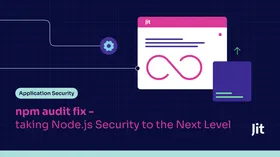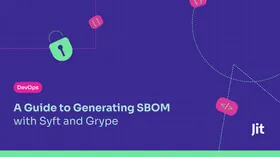Top 10 Code Security Tools in 2025
Updated June 11, 2025

Not all vulnerabilities are caught at the code level. It’s surprisingly common for flaws to pass through into production, exposing your application to risks like privilege escalation, data breaches, and malicious code injections. Using code security tools, you can integrate continuous security scanning into the SDLC to automate the vulnerability detection process.
70% of apps that have been live for five years contain at least one security flaw, and 32% of apps are found to have vulnerabilities during their first scan. The longer these vulnerabilities go unchecked, the harder – and more expensive – they are to fix.
Automating code security transforms the way you handle vulnerabilities. Instead of reacting to issues in production, you’re proactively catching them at the code level long before they evolve into serious threats.
Top 10 Code Security Tools in 2025 at a Glance
- Best overall code security tool in 2025: Jit
- Best code security tool for pattern matching: Semgrep
- Best code security tool for Go-specific security: Gosec
- Best tool for enterprise SAST platforms: Checkmarx
- Best code security tool for configuration security: Spectral
- Best tool for cloud-based enterprise SAST: Veracode
- Best tool for supply chain security: Myrror
- Best tool for hybrid security testing: Fortify On Demand
- Best tool for compliance-focused analysis: Parasoft
- Best tool for container-native security: Aqua
What Are Code Security Tools?
Code security tools help identify vulnerabilities in your source code, scanning for issues like buffer overflows, SQL injection points, and weak authentication logic. By leveraging techniques such as abstract syntax tree (AST) parsing and data flow analysis, they detect potential security risks early in the development cycle without requiring code execution, enabling faster issue resolution.
Integrating these tools into your CI/CD pipeline automates security checks for each build, preventing insecure code from reaching production. They work alongside tools like SCA to scan for dependency risks, providing detailed insights into code security within a comprehensive security strategy.
Key Features to Look for in Code Security Tools
- Static code analysis (SAST): Scans source code for vulnerabilities before deployment using predefined or customizable rules to detect insecure coding patterns.
- Runtime context awareness: Links static findings with real-time execution data through context-aware analysis to reduce false positives and highlight exploitable risks.
- Detailed reporting: The best tools provide root cause analysis, highlight affected code lines, and offer specific remediation steps. This saves time and helps you improve and automate IT processes, from vulnerability management to code deployment.
- Developer-centric UX: Offers a clean interface, pull request annotations, and IDE integrations that make secure coding part of everyday workflows.
- Automated fix suggestions: Delivers actionable remediation advice directly in developer IDEs or CI pipelines, minimizing the burden of manual fixes.
- Customizable rules: Look for customizable scanning features that allow you to fine-tune the tool to your unique environment—such as specific coding standards, enforcing organization-wide policies, or focus on particular vulnerability types relevant to your application stack.
- CI/CD integration: Integrates with DevOps pipelines—like GitHub Actions, GitLab, Bitbucket, or Jenkins—to run checks during build, test, and deploy stages.
- Shift-left enablement: Surfaces issues early in the development lifecycle, allowing devs to remediate in real-time and reducing the cost of fixing security flaws later.
- Security coverage for multiple languages: Supports a wide range of programming languages and frameworks commonly used in modern development stacks (e.g., Python, JavaScript, Go, Java, etc.).
- Open-source risk detection: Flags insecure use of third-party libraries, outdated packages, and transitive dependencies that may expose projects to known CVEs.
- Compliance and policy enforcement: Allows teams to create or enforce secure coding policies aligned with standards like OWASP Top 10, PCI-DSS, or SOC 2.
Top 10 Code Security Tools in 2025
Benefits of Code Security Tools
Code security tools offer the advantage of catching vulnerabilities early, so you can secure your code from the get-go and avoid workflow disruptions later in the SSDLC.
- Automation: By automating code reviews, they reduce human error and help you stay on top of potential risks as part of your CI/CD security strategy. This way, your team can focus on building new features or improving existing capabilities while security stays seamlessly integrated into each release.
- Remediation: These tools do more than flag issues—they offer actionable insights with prioritized fixes, saving you time on manual checks and helping maintain consistent security standards across your codebase.
- Security posture reporting: By delivering real-time reports and facilitating better collaboration, your team can tackle vulnerabilities quickly, keeping code quality high and risks low. Reporting is also required to satisfy common security standards like SOC2, ISO 27001, and HIPAA.
Security Starts in Your Code
When security flaws sneak into production, the fallout can be devastating—expensive fixes, breaches, and a bruised reputation. Catching these issues early is the smart move, saving you time and money. That’s why code scanning tools are a must for keeping your code clean and secure from the get-go.
By integrating powerful tools like Semgrep and Gosec, Jit brings everything you need into one streamlined platform. You get real-time scanning, intelligent prioritization based on runtime context, and instant fixes right where you need them – directly in your development workflow. Catch issues early and resolve them fast so your code stays secure without interrupting your momentum.






